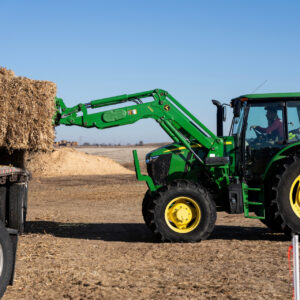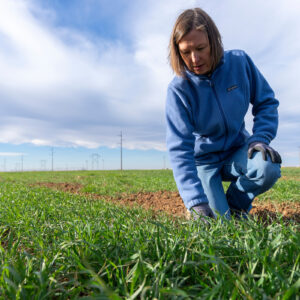Roland E. Roberts
Extension Horticulturist
Texas Agricultural Extension Service
Texas A&M University
In 1994, the f.o.b. value of Texas potatoes was over $35 million from 2.9 million cwt harvested from 15,000 acres. The spring crop of 5,500 acres yielded 1.1 million cwt., and the summer crop of 9,500 acres yielded 1.8 million cwt. In 1995 acreage planted for chip processing increased by 4,000 acres. In 1996 there were at least 19,000 acres of potatoes planted in Texas. More than 30% of the total acreage of Texas potatoes is planted for processing. It is estimated that for the 1998 season, planted acreage will be over 3,000 acres in the Rio Grande Valley, at least 10,000 acres for the Winter Garden (mainly Frio County), and 12,000 acres for the High Plains for a total of 25,000 acres.
Areas of Production
Potatoes are grown in all Texas regions with major commercial vegetable production. Large commercial acreage is grown in four areas: The High Plains – Panhandle, extending from Seminole northward to Dalhart; the Rolling Plains – Munday; the Upper Coast – Winter Garden; and the Rio Grande Valley.
Planting begins in the Rio Grande valley in late December and in the Winter Garden by mid January. In the Rolling Plains planting begins in mid February and continues through mid March. In the southern High Plains near Seminole, planting starts in late February. Planting continues through March on Farwell, Springlake, Hart, Olton, and Plainview potato farms. Last to plant, in early April, are Hereford and Dalhart.
Harvest Chronology
Harvesting begins in April in the Rio Grande Valley. The Winter Garden area harvests in late April through mid May. Digging begins in the Rolling Plains area in early June. The Seminole area of the High Plains starts to harvest by mid to late June. Muleshoe, Farwell, Springlake, Hereford, Dimmitt, Hart, Olton, and Plainview harvest is in full swing by early to mid July. Acreage in Dalhart is mostly for September-October harvest.
Climatic Requirements
Cool night temperatures coupled with high light intensity on the Texas High Plains during May favor tuber set, and cool nights (below 68 degrees F.) and high light intensity during June and July result in good set, quality size and yields ranging from 300 to 500 sacks per acre. High night temperatures during tuber set and tuber enlargement can reduce yields to levels below 250 sacks per acre.
The potato produces highest tuber quality and yield when air and soil temperatures are relatively cool. Mean air temperatures of 60 to 65 degrees F. (16 – 18 degrees C) are optimal for high yields. Potato leaves are not frost tolerant.
Tuber initiation is strongly influenced by air temperature and day length. Short days induce tuberization. Under long days, tuberization occurs if the night air temperature is well below 68 degrees F. (20 degrees C). Tuberization is optimal at night air temperatures of 54 degrees (12 degrees C). The temperature-sensitive parts for tuberization are the tops not the stolons. This explains why we have less tubers set per plant when day temperatures are over 90 degrees F., and night temperatures are in the high 60’s by mid May, when our day length is approaching 14 hours. It is known that for every one degree F. above the optimum air temperature for tuberization, the yield of potatoes can be lower by about 4%.
Water Requirements
Estimated daily water consumptive use was calculated for a mid March planted potato crop to be harvested in late July. The estimated consumption for March is 0; for April = 1.5 inches; for May = 7.2 inches, for June = 12.0 inches; and for July = 6.0 inches. The total estimated water consumption for the crop is 26.7 inches. Actual irrigation records show a total of 24 to over 40 inches has been applied in past years, depending on variety, planting date, harvest date, and seasonal weather.
Soil Types
Potatoes are adapted to most Texas soils, provided they are well-drained. Heavy clay soils should be avoided. Good yields are produced on the clay loams, sandy loams, and loamy sands. Harvesting is easier on sandy loams and loamy sands after rain. Most High Plains potatoes are planted in sandy loams and loamy sands. Russeting and skin set are better in sandier soils.
Plant Nutrition and Fertilizers
A 400 cwt/acre potato crop can remove 210 lb of nitrogen, 30 lb of phosphorus, and 275 lb of potassium. Potato plants require relatively high soil fertility for production of strong tops and premium size tubers of high quality. Nutrient requirements occur early in the growth of the plant, thus all phosphorus and potassium and at least half the total nitrogen fertilizer is usually applied at or just before planting. The fertilizer should be banded 2 inches to the side and 1 inch below on both sides of the seed piece, but most growers no longer band fertilizer. Sidedress nitrogen is applied to potatoes grown on light sandy soils. For maximum response, sidedress nitrogen can be applied to target specific plant nutrient objectives related to growth stage. Petiole testing on a regular basis can be a very useful nitrogen management tool.
Target Petiole Nitrogen Concentration to Maintain Maximum
Yield & Quality Of Norgold Russet M Potato
| I. Vegetative Growth | ||
| II. Tuber Formation | ||
| III. Tuber Growth | ||
| IV. Tuber Maturation |
It has been estimated that the tubers and vines of a 400 cwt/acre potato crop contain 210 pounds N, 30 pounds P, and 275 pounds K. Fertilizer application rates vary with soil types, climatic conditions, varieties and fertility levels of the soil. About 180 to 250 pounds of applied nitrogen (expressed as N), 300 to 400 pounds of applied phosphorus (expressed as P205) and 300 to 400 pounds of applied potassium (expressed as K20) are required per acre for good potato yields if these three essential elements are at low levels in the soil. High Plains soils are very high in naturally available potassium — with the exception of the Tivoli Sands — and most do not require potassium fertilizer to maximize yield and quality. Some soils are very high in phosphorus; however, research on the High Plains has shown that potato yields are increased by application of 100 to 200 pounds phosphorus fertilizer (P205 equivalent) even when soil test results show high to very high levels. Some growers believe that potassium fertilization improves yield and quality and apply 50 to 100 pounds (K2O equivalent)
Varieties
Many potato varieties are grown in Texas. Red La Soda and Viking are the principal red skin varieties. White skin potato varieties grown for chip processing include Atlantic, Snowden, Gemchip, and Norchip. Norgold M, Russet Norkotah (Texas selections 112 and 278) and Century Russet are the most popular russet skin varieties. Century Russet has shown heat tolerance here under professional management. Texas Norkotah selections 112 and 278 show strong potential. Yukon Gold, a yellow flesh, white skin variety is a specialty potato now being planted in increasing acreage by growers. The potato is extremely sensitive to stresses imposed by high temperatures, wind, too dry soil, and diseases. Potato varieties vary in performance from year to year depending on seed tuber source, seed tuber handling, weather and management.
Disease resistance, size, color, uniformity, earliness and yield are of prime importance in variety selection. High specific gravity and low levels of reducing sugar in the tuber at harvest are desirable in varieties for baking and for processing.
The potato blossom is a complete flower and normally is self fertile. In the field, potato blossoms occasionally set fruit. This fruit resembles a small green tomato and is seldom larger than an inch in diameter. A potato fruit does not result from a cross between potato and tomato.
Seeding Rates, Spacing, Size, and Treatment
The amount of seed required to plant an acre varies with plant spacing and size of the seed piece. Usually 1,600 to 2,200 pounds of seed pieces are required to plant an acre. Potatoes usually are planted in rows 32 to 38 inches apart, with 7 to 9 inches between tuber seed pieces. Closer spacing in fertile land has proved beneficial in reducing production of oversize tubers and increasing yields. Seed should be cut to weigh 1¾ to 2 ounces each. B- size potatoes can be used as seed-pieces to eliminate the cost of cutting larger potatoes, and to lessen the chance of spreading infection s diseases during the cutting operation. Usually, a better stand results from using whole potato seed.
Use only certified, disease-free seed potatoes. See the section on Disease Control for seed piece treatments for disease control.
Land Preparation and Planting
The land should be deep plowed and then disked just before planting. On some fields, it may be necessary to finish the land with a spike-toothed narrow to break clods and level the land. Proper leveling of land is essential before final preparation of the seedbed.
Plant early potatoes only when soil temperature at 6-inch depth has risen to 50o F. This soil temperature usually occurs 3 to 4 weeks before the frost-free date. Plant to a depth of 4 to 8 inches, measured from the top of the seed piece to bed level. Plant deeper in sandy soil. Increased yields and higher prices warrant the risk of frost damage by early planting. However, planting too early or too deeply may cause increased seed piece decay and Blackleg.
Irrigation
The most common method of irrigating potatoes in Texas is with low pressure center pivots. Adequate soil moisture at planting time is preferred. Prewater to provide adequate soil moisture at planting time. Avoid irrigating the crop up. Seed piece decay and Blackleg are usually more troublesome when the soil around the seed piece is flooded prior to shoot emergence
Four to ten irrigations may be needed during the growing season, depending on rainfall and the variety planted. Growers usually examine the plants and the soil in the root zone (3 to 6 inches below the seed piece) to estimate need for irrigation. Abnormally dark bluish-green leaves, wilted growing points, and soil from the root zone that fails to form a tight ball when compressed by hand are indicators of moisture stress. Growers of high yielding potato crops irrigate before plants or soil show moisture stress.
Some leading growers use soil moisture tensiometers and PET measurements to schedule irrigation and prevent moisture stress. The tensiometer is an instrument which accurately senses the tension in the water film as moisture is pulled into the roots from the soil. Tensiometer management must be adjusted to individual soil and crop conditions and cultural practices. Soil around the seedling root system must not be allowed to dry out. The first post-emergence irrigation should be applied when the soil moisture tension (SMT) at the 12-inch depth reaches 20 centibars in the morning of a bright day. Subsequent irrigations are scheduled to prevent the SMT at the 12-inch depth from reaching as high as 30 centibars. Again, this usually means irrigating whenever the SMT is over 20 centibars or higher in the morning of a clear day. Moisture stress (SMT readings above 30 centibars at the 12-inch depth) during tuber enlargement will result in lower yield of premium size tubers. Secondary growth on tubers (knobs and necks) results from moisture stress followed by irrigation or heavy rainfall. Excessive soil moisture favors Blackleg, Rhizoctonia disease and enlarged lenticels. Furrow watering every other bed prevents excessive soil moisture conditions in clay loam soils.
Cultivation
Cultivation is necessary only for incorporating herbicides, forming a hill 6 to 8 inches high over the seed piece and 12 inches wide on the top, or breaking up a crusted condition of the bed surface. The first bedding is best done when the plant tops are at least 4 to 6 inches above the soil surface. Hilling can be delayed until plants are taller, but earlier hilling will assure cooler soil (65 to 70o F.) in the zone where stolons and tubers form, and this is beneficial to their development.
Weed Control
Weeds emerging after the last cultivation often are a serious problem because they reduce the efficiency of mechanical harvesting. Most annual weeds and grasses can be controlled by applying recommended herbicides before planting or during the early growth stages. Treflan, applied at the rate of 1 to 2 pints per acre, incorporated 1 ½ to 2 inches deep, gives satisfactory control of most annual weeds and grasses. Dual herbicide is a widely used, broad spectrum herbicide which controls broadleaf and grass weeds in addition to yellow nutsedge. POAST is sprayed postemerge to control grasses and it does an excellent job on Johnsongrass.
Diseases and Insects
Potatoes are exposed to many disease organisms during the growing season. Most disease losses can be prevented by careful culture and timely applications of protective fungicides. Cut seed should be thoroughly coated with fungicide dust when seed are cut. Blackleg is more prevalent in plants grown from seed infected with Fusarium, so the grower should not accept seed infected with dry rot.
Early blight and late blight can be prevented by applying fungicides in strict compliance with label directions. Tattoo C is effective on Ridomil tolerant strains of late blight.
Crop rotation and sanitation will help to prevent scab, Rhizoctonia disease, and southern blight. For more detailed control recommendations, see B-1140B, Texas Plant Disease Handbook, Chemical Control Supplement for Vegetables.
Insects
Potatoes can be damaged by several insect pests including aphids, psyllids, and fleabeetles. Careful inspection of the crop during the growing season is necessary to minimize or prevent crop damage. Proper selection of insecticides and timing of applications are necessary to achieve satisfactory control. Refer to B-1305, Texas Guide for Controlling Insects on Commercial Vegetable Crops (Texas Agricultural Extension Service) for additional information on the latest recommended control measures. Follow label directions concerning rates, time of application, and safety precautions.
The chemicals and procedures stated herein for the control of weeds, diseases and insects comply with Environmental Protection Agency label registrations in force on the date that this publication was printed. However, subsequent changes in EPA regulations may cause any of these chemical usages to be in error. Be sure to adhere strictly to usage restrictions on the current label for the chemical you intend to use.
| The chemicals and procedures stated herein for the control of weeds, diseases and insects comply with Environmental Protection Agency label registrations in force on the date that this publication was printed. However, subsequent changes in EPA regulations may cause any of these chemical usages to be in error. Be sure to adhere strictly to usage restrictions on the current label for the chemical you intend to use. |
Harvest
Although harvest time depends primarily on maturity of the crop, other factors, such as weather conditions, market prospects and the labor situation influence harvest decisions of Texas growers. Optimum maturity is reached when most of the tubers are between 6 and 12 ounces and the skin is set.
To ensure good skin-set, the plants should mature and die before harvest. Often it is necessary to kill plants before harvesting. Gramoxone Extra is the preferred vine killing chemical, applied at least 3 to 7 days before harvest. If Gramoxone is applied while the vine is still growing and tubers are still sizing (growth stage 3), skin set may require up to two weeks. Sulfuric acid at 20 gallons per acre applied 5 days before harvest has been used, but acid resistant sprayers must be used.
In Texas, most potatoes are harvested mechanically with potato combines. Harvested potatoes are hauled to the packing shed in bulk trucks. The tubers are washed, sized and graded, then placed in 100-pound bags or 50-pound cartons for shipment. Graded sizes are U. S. #1 unsized, U. S. #1 Size A, U. S. #1 6 to 14 oz., and U. S. #1 70 to 110 count size. The U. S. #1 70 to 110 count sizes are packed in 50-pound cartons.
Cost and Returns
The costs and returns for potatoes change from year to year as the cost of inputs and market prices fluctuate. The total cost of producing and marketing Texas potatoes for fresh market ranges from $1,800.00 to $2,200.00 / acre at current yields.
Harvesting and marketing costs per acre vary with yield. With higher yield, the production cost per sack decreases while harvesting and marketing costs per sack remain the same.
The information given herein is for educational purposes only. Reference to commercial products or trade names is made with the understanding that no discrimination is intended, and no endorsement by the Cooperative Extension Service is implied. Educational programs conducted by the Texas Agricultural Extension Service serve people of all ages, regardless of socioeconomic level, race, color, sex, religion, disability or national origin.
The Texas A&M University System, U.S. Department of Agriculture, and the County Commissioners Courts Cooperating.





